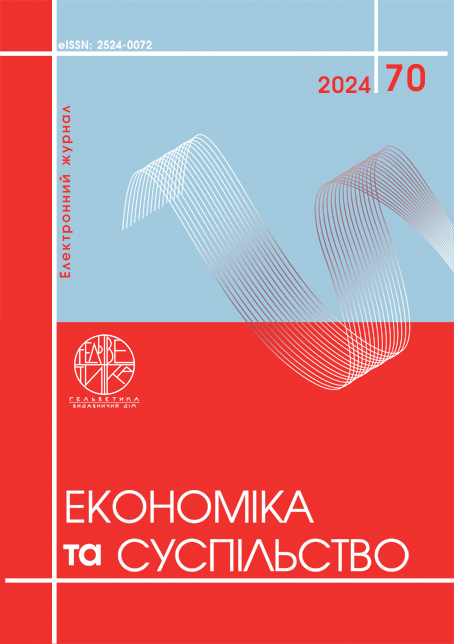INNOVATIVE DIRECTIONS OF THE USE OF MEDICINAL PLANTS IN DIETARY NUTRITION
Abstract
Dietary nutrition is based on the principle of maximum balance of essential nutrients in the daily diet and is an obligatory part of complex treatment. It should be noted that the therapeutic effect of dietary nutrition is ensured by a special selection of food products; certain ratios between essential nutrients and the appropriate technology for preparing dietary dishes. The relevance of the topic lies in the fact that medicinal plant raw materials are an inexhaustible source of natural biologically active substances that, even in minimal quantities, have a beneficial effect on the human body. Medicinal plants have long been used in nutrition along with dietary recommendations, because medicinal plant raw materials complement diet therapy and enhance its effectiveness. The purpose of the study was to select and substantiate the types of medicinal plants for use in dietary nutrition; to analyze the effectiveness of the use of this raw material; to determine innovative directions for the use of medicinal plants in dietary nutrition. Therefore, we are considering types of local medicinal plants with the feasibility of their use in dietary nutrition, namely: nasturtium flowers, quinoa (garden, red), honeysuckle. Nasturtium flowers are the edible parts of a herbaceous plant with the botanical name Tropaeolum, grown for ornamental, food and medicinal purposes. The taste is spicy, sharp, slightly sour, but pleasant. Red quinoa, garden quinoa, French lettuce, mountain spinach – this plant has many names. But it is this species of the quinoa genus of the amaranth family that is cultivated as a vegetable crop. Garden quinoa has a slightly salty, mild spinach-like taste and is practically odorless. Honeysuckle is a perennial herbaceous honey-bearing, fodder, decorative plant. It has been established that medicinal plants or their individual physiologically functional ingredients are actively used not only as a medicinal agent, but also as components of food products to improve the human diet for the preparation of very tasty fresh vitamin salads, for addition to soups, for the preparation of purees, sauces. Because, according to experts, the Ukrainian consumer does not maintain a number of useful essential substances with food.
References
Козонова Ю.О., Пруц Д.Ю. Функціональні напої для спортсменів. Холодильна техніка та технологія. 2014. № 3 (149). С. 60–63.
Огляд внутрішньої торгівлі продуктами переробки овочів, плодів до інших частин рослин у січні-березні 2005 р. Агроогляд. 2005. № 6. С. 32–35.
Долінський А.А., Шаркова Н.О., Авдєєва Л.Ю. та ін. Сучасна технологія виробництва функціональних напоїв на основі сої. Наука та інновації. 2006. Т 2. № 5. С. 78–80.
Жулінська О.В. Нові технології безалкогольних напоїв оздоровчого призначення. Технічні науки – технологія продовольчих товарів. 2013. №12. С. 56–58
Козонова Ю.О., Пруц Д.Ю. Функціональні напої для спортсменів. Холодильна техніка та технологія. 2014. № 3 (149). С. 60–63.
Никитчин Д.І. Олієвмісні культури. Запоріжжя : ВПК «Запоріжжя», 1996. 255 с.
Hera, E. Studies of the quality of cakes made with wheat-lentil composite / E. Hera, E. Ruiz-Paris, B. Oliete, M. Gomez // LWT-Food Sci and Technol. 2014. Vol. 49. № 1. Р. 48–54.
R. Ayerza, W. Coates. Protein content, oil content and fatty acid profiles as potential criteria to determine the origin of commercially grown chia (Salvia hispanica L.). Industrial Crops and Products, 34 (2) (2011), pp. 1366–1371.
Muñoz L.A. Chia seed (Salvia hispanica) / Muñoz L.A., A. Cobos, O. Diaz, J.M. Aguilera. / An ancient grain and a new functional food // Food Reviews International, 29. 4. 2013. Р. 394–408.
Timilsena Y.P. , R. Adhikari, S. Kasapis, B. Adhikari. Molecular and functional characteristics of purified gum from Australian chia seeds. Carbohydrate Polymers, 136 (2016), Р. 128–136.
Ribes S. Chia seed mucilage as a fat replacer in yogurts: Effect on their nutritional, technological, and sensory properties / S. Ribes, N. Peña, A. Fuentes, P. Talens, M. Barat // Journal of Dairy Science. Volume 104, Issue 3, March 2021, Pages 2822–2833.
Паска М., Млинко О. Технологічні аспекти використання функціональних напоїв у ресторанному бізнесі. Економіка та суспільство. 2023. № 52. DOI: https://doi.org/10.32782/2524-0072/2023-52-88
Паска М.З., Лескович О.В. Сучасні тенденції формування функціональних продуктів. Науковий вісник Львівського національного університету ветеринарної медицини та біотехнологій ім. Ґжицького. 2014. Том 16. № 3(4). С. 137–147.
Паска М.З. Інноваційний розвиток гастрономічного туризму Львівщини в контексті формування ресторанних брендів. Індустрія туризму і гостинності в Центральній та Східній Європі. 2022. № 5. С. 98–103. DOI: https://doi.org/10.36477/tourismhospcee-5-12
Kozonova Yu.O., Pruts D.Yu. (2014) Functional drinks for athletes. Refrigeration equipment and technology. 2014. No. 3 (149). P. 60–63. (in Ukrainian)
Oglyad vnutrishnoy torgivli productami pererobki ovochiv, plodiv ta inshih chastin roslin u sichni-berezni (2005). Ahroohlyad. № 6. P. 32–35.(in Ukrainian)
Dolinsky A.A., Sharkova N.O., Avdeeva L.Yu. et al (2006) Modern technology of production of functional drinks based on soy. Science and innovations. T 2. No. 5. S. 78–80. (in Ukrainian)
Zhulinska O.V. (2013) New technologies of non-alcoholic beverages for health purposes. Technical sciences – technology of food products. No. 12. S. 56–58. (in Ukrainian)
Kozonova Yu.O., Pruts D.Yu. (2014) Functional drinks for athletes. Refrigeration equipment and technology. No. 3 (149). P. 60–63. (in Ukrainian)
Nikytchyn D.I. (1996) Oil cultures. Zaporizhzhia: Industrial Complex "Zaporizhia". Р. 255 (in Ukrainian)
Hera, E. (2014) Studies of the quality of cakes made with wheat-lentil composite / E. Hera, E. Ruiz-Paris, B. Oliete, M. Gomez // Food Sci and Technol. Vol. 49. № 1. Р. 48–54.
Ayerza R., Coates W. (2011) Protein content, oil content and fatty acid profiles as potential criteria to determine the origin of commercially grown chia (Salvia hispanica L.) Industrial Crops and Products, 34 (2), pp. 1366–1371.
Muñoz L.A. (2013) Chia seed (Salvia hispanica) / Muñoz L.A., A. Cobos, O. Diaz, J.M. Aguilera / An ancient grain and a new functional food // Food Reviews International, 29 (4) pp. 394–408.
Timilsena Y.P., Adhikari R., Kasapis S., Adhikari B. (2016) Molecular and functional characteristics of purified gum from Australian chia seeds Carbohydrate Polymers, 136, pp. 128–136.
Ribes S. Chia seed mucilage as a fat replacer in yogurts: Effect on their nutritional, technological, and sensory properties / S. Ribes, N. Peña, A. Fuentes, P. Talens, M. Barat // Journal of Dairy Science Volume 104, Issue 3, March 2021, Pages 2822–2833.
Paska M., Mlynko O. (2023). Tekhnolohichni aspekty vykorystannya funktsionalʹnykh napoyiv u restorannomu biznesi. Ekonomika ta suspilʹstvo, (52). DOI: https://doi.org/10.32782/2524-0072/2023-52-88 (in Ukrainian)
Paska M.Z., Leskovich O.V. (2014). Modern trends in the formation of functional products. Naukovyy visnyk Lvivskoho natsionalnoho universytetu veterynarnoyi medytsyny ta biotekhnolohiy im. Gzhytskoho. No 16, No 3(4). Р. 137–147. (in Ukrainian)
Paska M.Z. (2022). Innovatsiinyi rozvytok hastronomichnoho turyzmu Lvivshchyny v konteksti formuvannia restorannykh brendiv [Innovative development of gastronomic tourism in Lviv region in the context of restaurant brand formation]. Industriia turyzmu i hostynnosti v Tsentralnii ta Skhidnii Yevropi, no 5, pp. 98–103. DOI: https://doi.org/10.36477/tourismhospcee-5-12 (in Ukrainian)

This work is licensed under a Creative Commons Attribution 4.0 International License.


